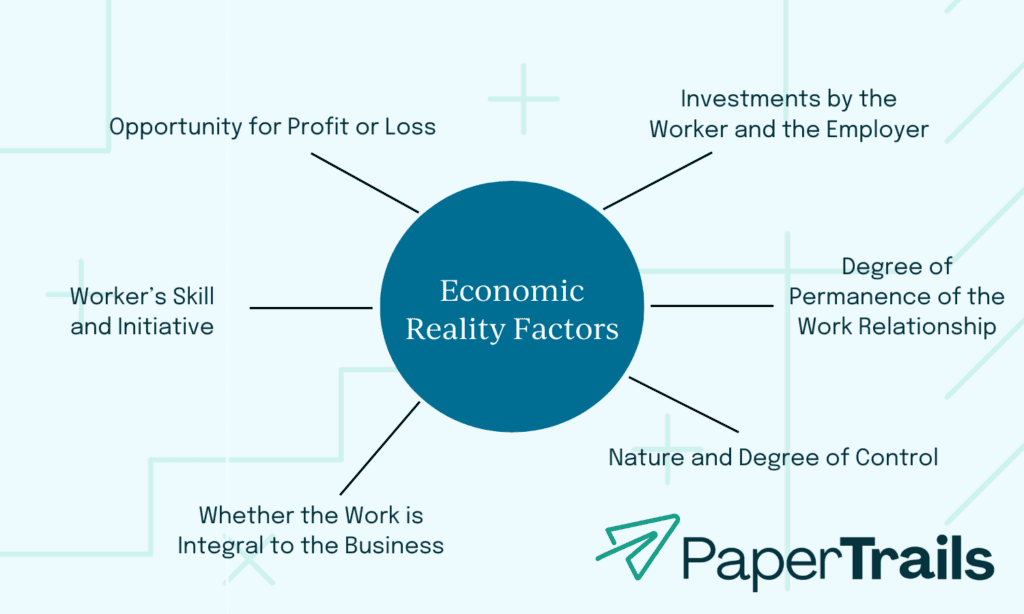In the world of employment law, the role of independent contractors has become increasingly significant. Recent statistics indicate that a substantial portion of the U.S. workforce, nearly 32 million workers, is now engaged in some form of independent contracting. Understanding the nuances of this engagement is crucial for small to medium-sized business owners. This blog post delves into the Federal Department of Labor’s (DOL) reinstatement of the longstanding independent contractor test.
At Paper Trails, we stay abreast of federal and local legislative changes to keep employers of all sizes aware of their responsibilities and compliance requirements. With the continued increase to the number of independent contactors that businesses may work with, understanding the independent contractor test is key. By the end, you will gain an understanding of what an independent contractor is, the background of the independent contractor test, the details of the newly reinstated test, and how these regulations may impact your business.
What is an independent contractor?
An independent contractor, or 1099 employee, is fundamentally different from a traditional W-2 employee. These 1099 employees are independent business owners and are not employed by the company. They are hired for a period of time and agreed upon fee set by a contract. 1099 workers may work for multiple companies throughout the year. They are not subject to the same level of control or oversight as W-2 employees and typically work on a project-by-project basis. Independent contractors have a significant degree of control over how they complete their work and typically engage with businesses through contractual agreements. This working arrangement offers flexibility and often specialized expertise to the businesses that hire them.
What is the background on the independent contractor test?
Historically, the independent contractor test has been a critical tool for determining the classification of workers. The distinction between an independent contractor and an employee is crucial, as it determines the application of employment laws, payroll taxation, and benefits. Over the years, various tests and standards have been developed by the DOL and the courts to make this distinction clear. The most widely recognized among these is the “economic reality” test, which considers multiple factors to assess the nature of the working relationship between a worker and a business.
For over 70 years, both the courts and the DOL have utilized these factors, or variations of them, in their assessments. However, the application of these factors has been inconsistent, with varying emphasis placed on each one. This inconsistency has often led to differing outcomes, even in cases where the facts seemed remarkably similar.
What are the federal changes to the independent contractor test?
Recently, the Federal DOL reinstated the longstanding version of the independent contractor test, effective March 11, 2024. This move marks a significant shift back to the multifactor, totality-of-the-circumstances analysis, replacing the 2021 independent contractor rule. The updated rule focuses on whether a worker is economically dependent on the employer (indicating an employee relationship) or is in business for themselves (indicating an independent contractor).
The factors considered in this analysis include:
- Opportunity for Profit or Loss: Examining whether the worker has the potential to earn profits or incur losses based on their managerial skill and business decisions.
- Investments by the Worker and the Employer: Comparing the nature and extent of investments by both the worker and the employer.
- Degree of Permanence of the Work Relationship: Considering the longevity and stability of the relationship between the worker and the employer.
- Nature and Degree of Control: Assessing the extent of control an employer has over the work and how it is performed.
- Whether the Work is Integral to the Business: Determining if the worker’s role is essential to the core function of the business.
- Worker’s Skill and Initiative: Evaluating whether the worker uses specialized skills in a manner that demonstrates business initiative and independence.

This nuanced approach allows for a more comprehensive evaluation of the working relationship, beyond just the financial aspects.
How does this impact my business?
As a small to medium-sized business owner, understanding and applying this independent contractor test is crucial. Misclassification of workers as independent contractors instead of employees can lead to significant legal and financial consequences. Here’s how the reinstated test impacts your business:
- Compliance with Employment Laws: Proper classification ensures compliance with employment laws, including minimum wage, (blended)overtime pay, and workers’ compensation.
- Tax Obligations: It affects how taxes are withheld and paid. Employees typically have taxes withheld by their employer, whereas independent contractors are responsible for their tax payments.
- Benefit Obligations: Misclassifying an employee as an independent contractor may result in failure to provide mandated benefits, leading to potential legal issues.
- Operational Flexibility: The test helps in making informed decisions about workforce management, balancing the need for operational flexibility with legal compliance.
- Risk Management: Understanding the test mitigates the risk of legal challenges and penalties associated with worker misclassification.
Conclusion
The Federal DOL’s reinstatement of the longstanding independent contractor test marks a return to a more traditional and comprehensive approach in determining worker status. For small to medium-sized business owners, staying informed and compliant with these regulations is key to successful business operation and workforce management. Ensuring that your workers are correctly classified not only aligns with legal requirements but also supports a fair and equitable working environment. As always, contact our team here for help with classifying your employees!